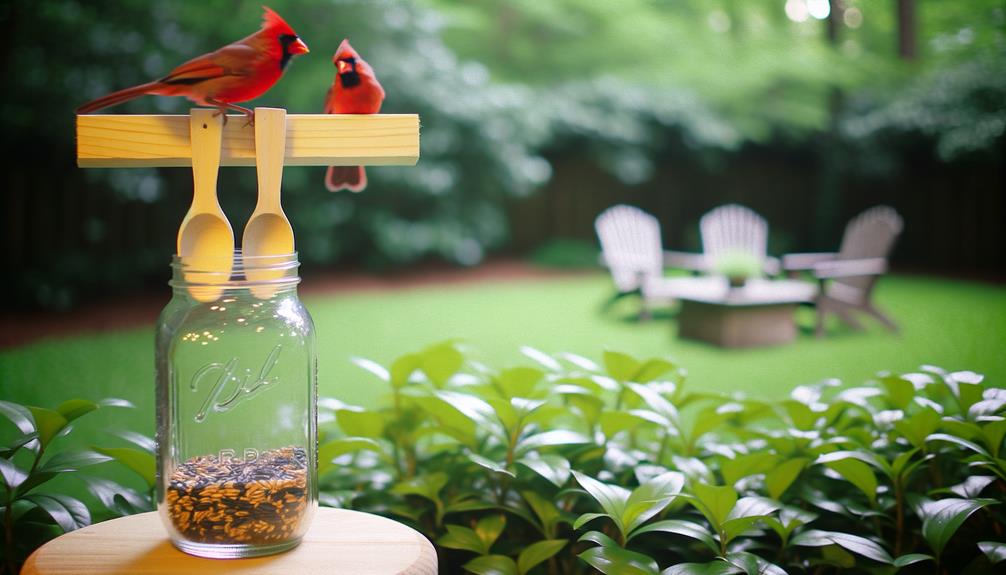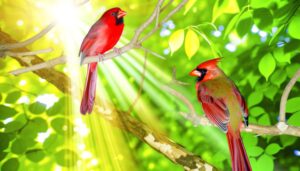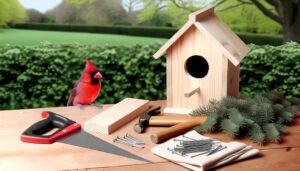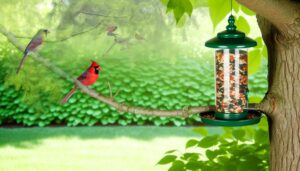5 Simple Steps to Craft DIY Bird Feeders for Cardinals
Creating DIY bird feeders for cardinals entails using untreated wood like cedar or pine for durability and stainless steel screws to resist rust. Position the feeders in well-lit, elevated areas near natural perches for visibility and safety.
You can design various feeders such as basic wooden feeders secured with galvanized screws, recycled bottle feeders with drilled holes, or spacious platform feeders. For a simple option, coat a pinecone with peanut butter and birdseed, and hang it using natural twine.
Regular maintenance with non-toxic solutions is essential. Continue to discover insights into feeder designs and best feeding practices.

Key Takeaways
- Use untreated wood like cedar or pine and stainless steel screws for durable and safe feeders.
- Place feeders 5-6 feet high in well-lit, sheltered areas near trees for protection and visibility.
- Create feeders with spacious flat surfaces to replicate natural feeding environments and accommodate multiple cardinals.
- Opt for versatile feeders, such as basic wooden feeders, hanging tray feeders, or suet log feeders to attract cardinals.
- Regularly clean feeders with non-toxic solutions and refill with cardinal-preferred seeds like black oil sunflower and safflower seeds.
Materials You'll Need
To construct a long-lasting and effective bird feeder for cardinals, you will need a specific set of materials including untreated wood, stainless steel screws, and weather-resistant sealant. Untreated wood, such as cedar or pine, is preferred due to its natural resistance to decay and its non-toxic properties, ensuring the safety of the birds.
Stainless steel screws are essential for their resistance to rust and corrosion, which guarantees structural integrity over time. A weather-resistant sealant is vital for protecting the wood from moisture and UV damage, extending the feeder's lifespan.
Additionally, consider incorporating a polycarbonate or acrylic sheet for the feeding area, which provides visibility and durability. These materials together create a strong, long-lasting feeder suitable for cardinals' needs.
Choosing the Right Spot
Selecting the best location for your DIY bird feeder is essential to attracting cardinals and ensuring their safety.
This process involves evaluating the visibility and accessibility of the feeder, ensuring it is positioned to protect the birds from predators, and situating it near natural shelters like trees or shrubs.
Each factor greatly influences the feeder's effectiveness and the well-being of visiting cardinals.
Visibility and Accessibility
Positioning your DIY bird feeder in an open, elevated area enhances visibility for cardinals while reducing accessibility to potential predators. Cardinals, known for their striking red plumage, require clear sightlines for safe approach and departure.
An elevated position not only improves their ability to survey the surrounding area for threats but also facilitates easier access to the feeder itself. Ideal placement includes locations that receive ample sunlight, as cardinals prefer well-lit areas.
Additionally, ensuring proximity to natural perches like trees or shrubs offers cardinals convenient resting spots. Such strategic placement minimizes disturbances and encourages regular visits.
Safety From Predators
Ensuring the safety of cardinals from predators necessitates a detailed evaluation of the feeder's location. Factors to consider include proximity to cover, height above ground, and visibility from various vantage points.
Positioning the feeder at a minimum height of 5-6 feet reduces the risk of ground-based predators. Simultaneously, maintaining a clear line of sight around the feeder enables cardinals to detect and evade aerial threats.
Placing the feeder at a moderate distance from dense foliage offers a balance between providing cardinals with nearby escape routes and minimizing ambush opportunities for predators.
Such strategic placement, informed by an understanding of predator behavior and cardinal habits, is essential for optimizing the safety and well-being of these vibrant birds.
Proximity to Shelter
Determining the best closeness to shelter for a bird feeder involves analyzing the specific environmental features that provide cardinals with both protection and ease of access. Ideal placement guarantees that these birds feel secure while feeding.
Consider these factors:
- Closeness to Trees and Shrubs: Position the feeder near dense foliage to offer cardinals quick escape routes from predators.
- Visibility: Guarantee the feeder is within a clear line of sight for the birds, allowing them to spot potential threats while feeding.
- Elevation: Mount the feeder at a height of 5-6 feet to deter ground predators like cats and squirrels.
- Wind Protection: Place the feeder in a sheltered area to minimize exposure to harsh winds, guaranteeing cardinals can feed comfortably.
Basic Wooden Feeder
Constructing a basic wooden feeder for cardinals involves selecting durable, weather-resistant materials and employing precise measurements to guarantee structural stability and functionality. Best wood choices include cedar or redwood due to their natural resistance to decay and insect damage.
Begin by cutting the wood into specified dimensions: a base platform of approximately 12 inches by 12 inches, side panels of 8 inches in height, and a roof to shield the feed from precipitation. Secure all joints with galvanized screws to prevent rusting. Make sure the design includes a perch and adequate spacing to accommodate cardinals' size.
Applying a non-toxic, water-resistant sealant can further extend the feeder's longevity, hence ensuring a sustainable feeding station for cardinals.
Recycled Bottle Feeder
In contrast to the traditional wooden feeder, a recycled bottle feeder offers an eco-friendly and cost-effective alternative for attracting cardinals. This method leverages readily available materials, minimizing waste and promoting sustainability.
To construct a recycled bottle feeder:
- Materials: Utilize a plastic bottle (500ml-1L), a wooden dowel, and wire or string for hanging.
- Preparation: Clean the bottle thoroughly to remove any residue.
- Construction: Puncture holes in the bottle for the dowel to serve as a perch, ensuring they are aligned and large enough for seed access.
- Installation: Fill the bottle with birdseed, secure the cap, and hang the feeder in a suitable location.
This design not only benefits cardinals but also supports environmental conservation efforts.
Hanging Tray Feeder
A hanging tray feeder provides an open and accessible feeding platform that is particularly appealing to cardinals due to its spacious design and ease of access. The feeder's horizontal layout allows multiple cardinals to feed simultaneously, minimizing competitive interactions. The platform's openness reduces obstructions, ensuring unobstructed visibility for the birds and facilitating rapid detection of predators. Additionally, the ease of maintenance and refilling makes it a practical choice for bird enthusiasts.
| Feature | Benefit |
|---|---|
| Open Design | Attracts multiple cardinals |
| Spacious Platform | Accommodates several birds |
| Minimal Obstructions | Enhances safety and visibility |
| Easy to Refill | Convenient for users |
| Simple Maintenance | Reduces upkeep effort |
This design is excellent for creating a welcoming environment for cardinals, ensuring consistent visitation and feeding.
Suet Log Feeder
While the hanging tray feeder offers an accessible platform for cardinals, the suet log feeder provides an alternative feeding method that attracts these birds with high-energy food sources, especially beneficial during colder months.
The suet log feeder consists of a log drilled with several holes filled with suet—an animal fat mixture enriched with seeds, nuts, and fruits. Cardinals are drawn to the high-fat content, which is essential for maintaining energy levels in winter.
Constructing a suet log feeder involves several steps:
- Select a solid log: Preferably hardwood, about 12-18 inches in length.
- Drill holes: Approximately 1-2 inches in diameter, spaced evenly.
- Fill with suet mixture: Make sure all holes are tightly packed.
- Mount securely: Attach the log to a tree or a sturdy post.
This design supports natural foraging behaviors and sustains cardinal populations through harsh seasons.
Platform Feeder
Platform feeders provide a versatile and efficient feeding station that caters to the dietary preferences and feeding habits of cardinals. Cardinals, being ground feeders, feel more comfortable and secure feeding from a flat, open surface. These feeders can accommodate a variety of food types, including seeds, fruits, and insects, ensuring a balanced diet. Additionally, the open design allows for easy cleaning, reducing the risk of mold and bacteria buildup, which is essential for maintaining bird health.
| Feature | Benefit |
|---|---|
| Spacious flat surface | Mimics natural feeding environment |
| Versatile food options | Supports diverse dietary needs |
| Easy to clean | Promotes hygienic conditions |
| Elevated design | Keeps food dry and accessible |
| Open visibility | Reduces bird stress during feeding |
Understanding these attributes allows bird enthusiasts to provide an ideal feeding experience for cardinals.
DIY Pinecone Feeder
To construct a DIY Pinecone Feeder, it is essential to gather specific materials such as pinecones, peanut butter, and birdseed, along with basic tools like a spreading knife and string.
The assembly involves methodically coating the pinecone with peanut butter and rolling it in birdseed, ensuring an even application to maximize attractiveness to cardinals.
Strategic placement of the feeder, ideally in sheltered locations and at varying heights, optimizes accessibility and enhances the likelihood of cardinal visits.
Materials and Tools Needed
For the construction of a DIY pinecone feeder specifically designed for cardinals, you will need to gather several essential materials and tools to guarantee both structural integrity and functionality. These items are carefully selected to assure the feeder is both appealing to cardinals and durable in outdoor conditions.
The materials and tools required include:
- Large pinecones: These serve as the primary structure for the feeder, providing ample surface area for seed adherence.
- Natural peanut butter: Acts as an adhesive substrate, enabling seeds to stick firmly to the pinecone.
- Birdseed mix for cardinals: This specialized mix attracts cardinals and meets their dietary preferences.
- Twine or string: Used to hang the pinecone feeder securely from tree branches or other support structures.
Collecting these items guarantees a robust and functional feeder.
Assembly and Placement Tips
Once all necessary materials and tools are gathered, the first step in assembling the DIY pinecone feeder involves thoroughly coating the pinecone with natural peanut butter. This adhesive layer will attract cardinals and provide a base for the subsequent seed application.
After evenly spreading the peanut butter, roll the pinecone in a mixture of black oil sunflower seeds and safflower seeds, ensuring uniform coverage. The seeds' high oil content is particularly appealing to cardinals.
Secure a length of natural twine to the pinecone's top for hanging. For ideal placement, select a location that is elevated and close to dense foliage, providing both a food source and a sense of security for the birds.
Regularly monitor and replenish the feeder as needed.
Cleaning and Maintenance
Regularly cleaning and maintaining your DIY bird feeders is important to prevent the spread of diseases among cardinals and secure the longevity of the feeders. A systematic approach guarantees the hygiene and durability.
Follow these steps for effective maintenance:
- Weekly Cleaning: Disassemble the feeder and use a non-toxic soap solution to scrub all components. Rinse thoroughly to remove any residue.
- Sanitization: Once a month, soak parts in a diluted bleach solution (1 part bleach to 9 parts water) for 10 minutes. Rinse well to eliminate any chemical traces.
- Drying: Ensure all parts are completely dry before reassembly to prevent mold growth.
- Inspection: Regularly check for damage or wear, such as cracks or rust, and repair or replace parts as needed.
These practices help maintain a healthy environment for cardinals.
Best Foods for Cardinals
Maintaining clean and functional bird feeders is only part of the equation; providing cardinals with the most nutritious and appealing foods is equally important to attract and sustain their presence in your backyard. Cardinals have specific dietary preferences that enhance their health and vibrancy. Below are some of the best foods for cardinals:
| Food Type | Nutritional Benefit |
|---|---|
| Black Oil Sunflower Seeds | High in fat, supports energy requirements |
| Safflower Seeds | Rich in protein, preferred by cardinals |
| Nyjer (Thistle) Seeds | Good source of essential fatty acids |
| Cracked Corn | Provides carbohydrates for sustained energy |
These choices not only meet their dietary needs but also encourage regular visits, ensuring your feeders remain lively with these striking birds.
Conclusion
To sum up, constructing bird feeders for cardinals necessitates a careful selection of materials and strategic placement to attract these vivid avian visitors.
Various feeder designs, ranging from fundamental wooden structures to creative recycled bottle feeders, provide chances to cater to cardinals' feeding preferences.
Furthermore, ensuring feeder cleanliness and offering suitable food like sunflower seeds can notably improve the chances of cardinal visitation.
This combination of meticulous planning and execution turns a basic backyard into a sanctuary bustling with avian brilliance, resembling a living tapestry.






